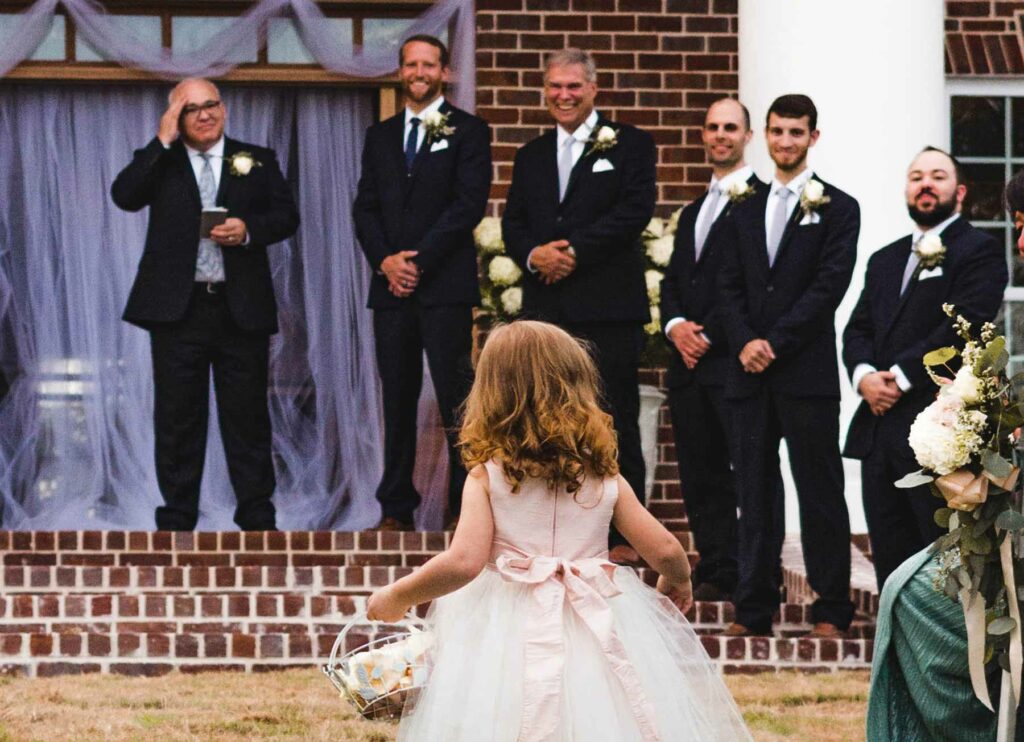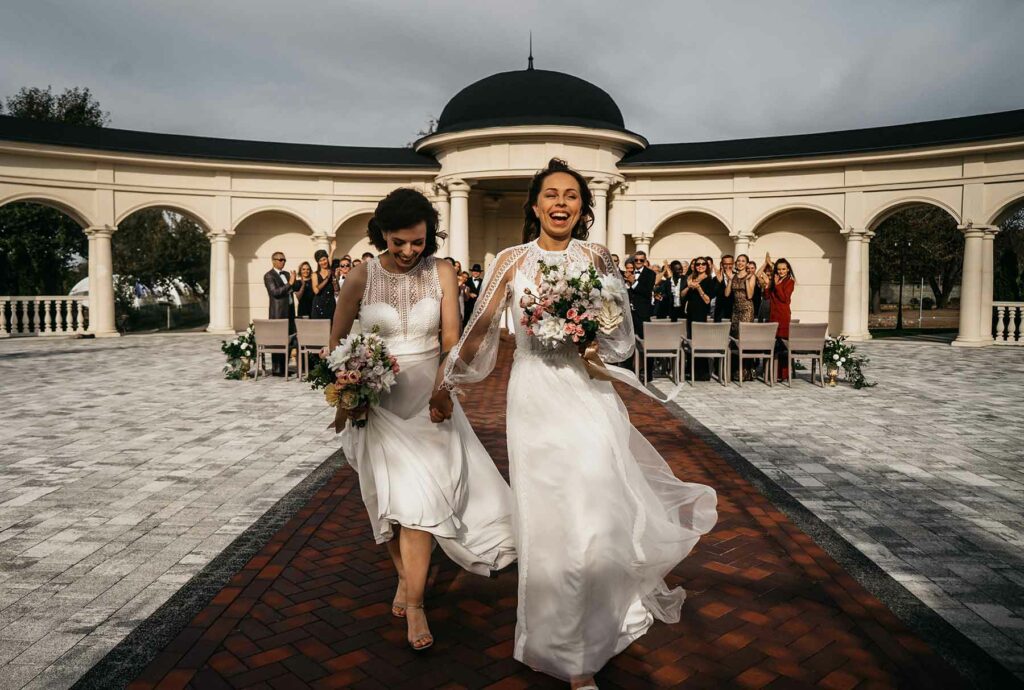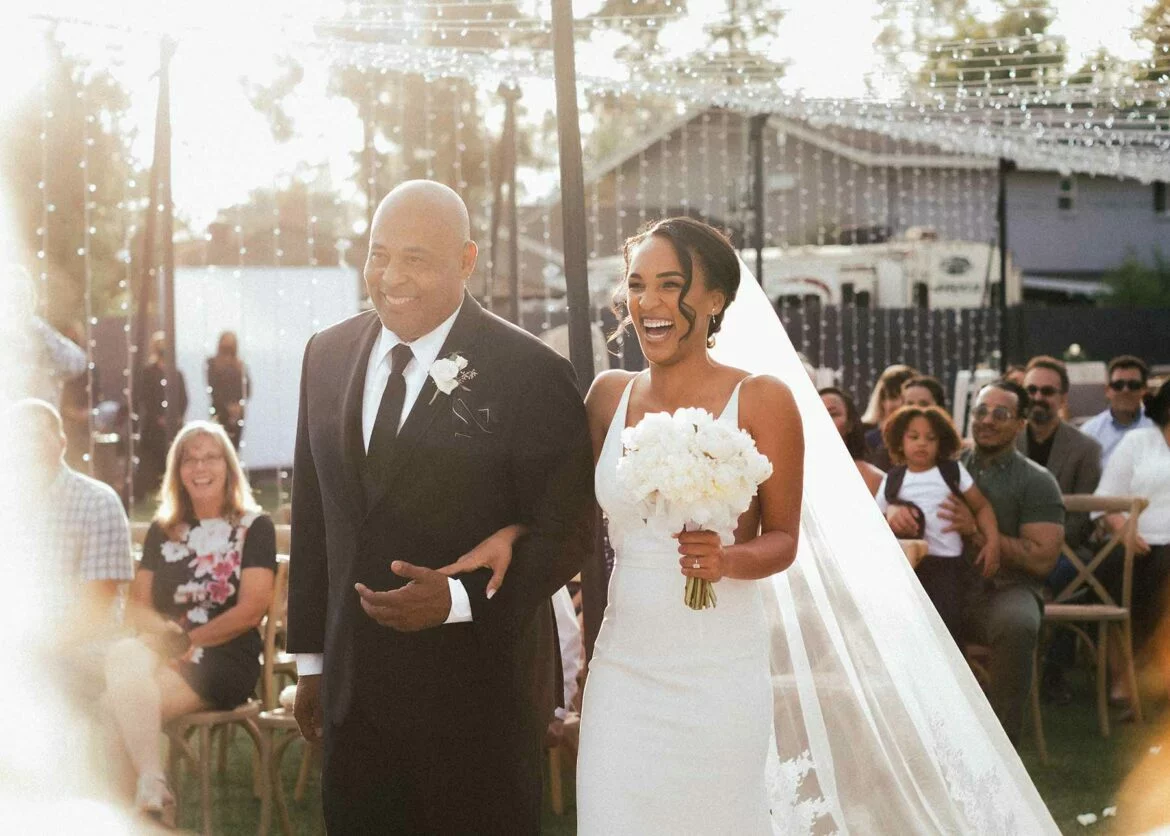Last Updated on August 29, 2024 by Joy Editors
A wedding processional order is the traditional order of honored individuals walking down the aisle. The order usually follows from first to last: officiant, groom, best man, wedding party, maid/matron of honor, ring bearer, flower girl, and finally the bride with her father or escort.
Trying to envision how you’ll walk down the aisle on your big day? Or better yet, who all will enter before you make your grand entrance? The concept of a wedding processional order is a pretty formal entry moment marking the beginning of your wedding ceremony. Planning it, however, requires some thought.
But not to worry — we have a guide to help demystify this part of your wedding planning process. We also include a handy guide of wedding processional orders in different types of ceremonies.
From who traditionally walks down the aisle to unique ways to make it your own, here’s everything you need to know about choosing a modern wedding processional order.
What Is a Wedding Processional?
A wedding processional is exactly as it sounds: It’s the order in which people walk down the aisle at the start of a wedding ceremony. This symbolic and joyful moment sets the stage for your vows and union at the altar.
Think of your wedding processional as a chance for all of your guests to see the happy couple and other people who have played an important role in your relationship leading up to the wedding day. Just like choosing a wedding party, deciding on who will precede you down the aisle and the order they walk into your ceremony is totally up to you. The most important thing is that you and your partner feel like the processional aligns with your personal style and values. Maybe a traditional, grandiose professional doesn’t feel like the right fit — or perhaps that’s exactly what you’re looking for. Maybe it’s something in between. The good news is you get to choose, and there are plenty of ways to make this wedding tradition your own.
Wedding Processional Order 101: Who Walks and When
The wedding processional reads like a “who’s who” of your relationship. It’s a chance to introduce wedding guests to the special people who may have been there from the very beginning and watched your romance blossom into the love that led to the big day. Since there are no doubt a number of people you may want to take that walk down the aisle with you, include as many, or as few, as you’d like. Here are the most common participants in the traditional processional order.

The officiant
The officiant, usually a minister, celebrant, or religious leader, begins the procession and takes their place at the altar or ceremony space. In some cases, the officiant may already be standing in place, but in others, you might choose to have them process with the rest of the wedding party.
The groom
Following the officiant is traditionally the groom, who generally comes in from a side entrance to stand, not down the aisle, to join and wait at the altar. The best man often accompanies the groom, also coming in from the side before the remaining wedding party walks down the aisle.
The wedding party
Next, the bridesmaids and groomsmen (or entirely different roles you’ve defined on your own) process in pairs or individually. They will typically line up on opposite sides of the ceremony space, next to each other. The following participants are also popular additions to the processional:
- The ring bearer (optional): This is typically a male child, such as a nephew, entrusted with carrying the wedding rings on a pillow down the aisle. He often precedes the flower girl or walks with her. Some nontraditional ceremonies may instead have a beloved pet as the ring bearer as a creative and heartwarming addition.
- The flower person (optional): This is traditionally a young girl, such as a niece, but can be anyone who can scatter flower petals down the aisle before the bride.

People of honor
It’s also common to honor those people who hold a special place in your heart with a moment of their own, such as grandparents. While including grandparents is traditional in a Jewish wedding processional, it doesn’t mean the practice is limited to just religious ceremonies. If you want your grandparents to have a special moment at your wedding, invite them to walk down the aisle!
The bride and family
Traditionally, the bride enters last, escorted down the aisle by her father (or another chosen family member). The father or escort symbolizes the family “giving away” the bride to the soon-to-be spouse and family-in-law.
Joy Tip: It’s also worth noting that if you want someone to escort you or your soon-to-be spouse down the aisle, that decision is yours to make. Families, weddings, and roles come in all shapes, sizes, and textures. Think about what will make your special day the most special, and follow your heart.
Christian Wedding Ceremony Processional Order
Before diving in, it’s worth noting that in traditional Christian wedding ceremonies for heterosexual couples, the bride will stand on the left side of the altar, and her family and wedding guests will sit on that side as well. It’s also traditional for the parents to sit in the front row after entering. While parts (or all) of the processional can be adapted, here’s what the traditional order might look like.
- Parents of the groom, together
- Mother of the bride
- Officiant (a pastor, traditionally)
- Groom, traditionally escorted by the best man
- Wedding party
- Maid of honor
- Ring bearer
- Flower person
- Bride, traditionally escorted by her father
Jewish Wedding Processional Order
While same-sex couples are finding beautiful ways to incorporate Jewish traditions into their big day, a traditional gendered approach to this religious wedding processional will have the bride on the right side, as opposed to the left, with the family sitting on her same side. The couple, rabbi, and both sets of parents will typically stand beneath the chuppah, a traditional Jewish wedding canopy.
- Rabbi
- Grandparents of the couple
- All groomsmen
- Groom with his parents
- All bridesmaids
- Flower person
- Ring bearer
- Bride with her parents
Hindu Wedding Processional Order
The processional order at a Hindu wedding, while varying by region and family custom, typically begins with the entrance of the groom and his family on a white horse, followed by the bride and her family in a small carriage or “doli.”
Hindu ceremonies often include a significant number of attendees, with extended family members and close friends participating in the procession. Unlike Western weddings, the emphasis is not solely on the immediate wedding party but also on the collective presence of the families and community.
- Groom
- Family of the groom
- Family of the bride
- Bride with bridal party
Traditional Nondenominational Wedding Processional Order
Without religious requirements guiding the processional, you may find it confusing to land on an order that suits you best. While there’s certainly no “correct” way to walk down the aisle, here’s one example of what a more traditional nondenominational wedding processional might look like.
- Grandparents of the couple
- Parents
- Officiant
- First spouse
- Wedding party
- Person/people of honor
- Ring bearer
- Flower person
- Second spouse and a parent or other special person
Modern Wedding Processional Order
This is for couples not interested in having a “traditional” processional; throw the rulebook out the window! Whether you want to stick with tradition or give a nod to aspects of religious or cultural ceremonies you love, what matters most is that you’re fully in the moment before you say “I do.” That being said, here are a few creative ways to make it your own:
- Send the flower person out first — because why not let everyone in the wedding party walk down an aisle covered in flowers?
- Have a loved one or close friend officiate your wedding. They can easily get ordained online to become a wedding officiant in time for your big day.
- Both you and your partner can head down the aisle, whether it’s together or solo.
- Have your wedding parties stand opposite you so they can see your faces rather than your backs.
- If you want to exchange vows with just your partner at your side but still want to give your wedding party a moment of recognition, allow them to take a seat after walking down the aisle.
- Mix up your processional music. There’s nothing wrong with the classic Canon in D, but why not boogie to the Electric Slide if that’s your vibe?

FAQ
Choosing the perfect processional order is a personal choice that reflects your unique relationship and style. Whether you opt for a traditional lineup or a completely custom approach, the most important aspect is that the processional feels authentic and meaningful to you and your spouse-to-be.
Choosing the perfect processional order is a personal choice that reflects your unique relationship and style. Whether you opt for a traditional lineup or a completely custom approach, the most important aspect is that the processional feels authentic and meaningful to you and your spouse-to-be.
The traditional wedding processional order has its roots in Western Christian ceremonies, where the procession was seen as a symbolic journey. The bride’s father would accompany her down the aisle to “give her away” to the groom. While many couples still follow this tradition, it continues to evolve with new wedding trends.
After the processional, the vows, and the “I dos” comes — you guessed it — the recessional. No need to get too caught up here. Just have everyone leave in the reverse order of how they entered, all led by the newest of newlyweds.


